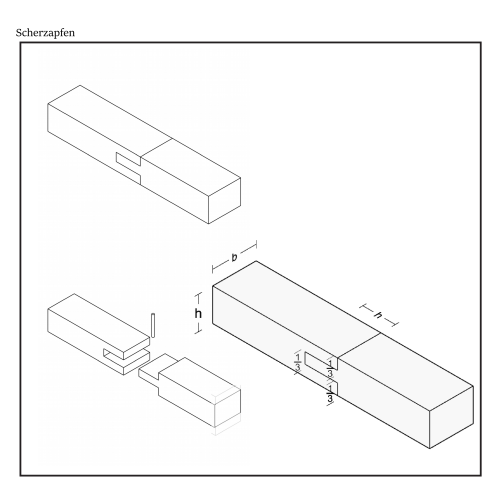shear leaf
Downloads
- Download 3DM File
- Download FactSheet File
The shear pin is mostly used for standing components (I - connections). This connection can also be found under the names shear blade, tenon joint and utility tenon. The tenon is always as long as the timber width or height. By securing the tenon with a wooden split pin, the joint can also be made without glue and smaller buckling loads can be accommodated (cf. Gerner, 1992, p. 56).
Mortise and tenon joints
Along with leaves, tenon joints are one of the oldest and most widespreada types of wood joint. The developmental stages of the tenon can hardly be traced, but it is certain that at the latest in 3000 BC wooden joints were made in the form of "insertion holes". Tenons for doors and gates were already known (cf. Gerner, 1992, p. 53). Due to the universal usability of tenons, they contribute decisively to constructive solutions and even make them possible. Thus, the mortise and tenon, a mortise and tenon that is secured with wedges or split pins, is considered the basis and most important element of all house frames and anchor beam constructions. For some constructions, the mortise and tenon joint is already considered the constructive basis at that time (cf. Gerner, 1992, p. 53).
Butt joints
Butt joints are, next to all support joints, the earliest forms of joints used. Butt joints mean that timbers are extended across corners or in one direction. Such joints are necessary in all inclined as well as horizontal components (cf. Gerner, 1992, p. 42).Further butt joints are often divided into the major joint types of tenons, leaves or dovetails. Furthermore, according to the required functions, compression, tension, lateral shear or shear forces can be absorbed, formed in a position-safe manner or secured against lifting. Thus, joints are classified in the large groups of joints as their own type of joint (cf. Gerner, 1992, p. 42).
Der Scherzapfen wird meist für stehende Bauteile (I - Verbindungen) genutzt. Diese Verbindung findet sich auch unter den Namen Scherblatt, Zapfenstoß und Nutzapfen. Der Zapfen ist immer so lang wie die Holz- breite oder Höhe. Durch die Sicherung des Zapfens durch einen Splint aus Holz kann die Verbindung auch ohne Leim erstellt werden und es lassen sich kleinere Knicklasten aufnehmen (vgl. Gerner, 1992, S. 56).
Zapfenverbindungen
Zapfenverbindungen gehören neben Blättern zu den ältesten und weitest verbreitetena Holzverbindungsarten. Die Entwicklungsstufen des Zapfens sind kaum nachzuvollziehen, jedoch steht fest, dass spätestens 3000 v. Chr. Holzverbindungen in Form von „Einsatzlöchern“ ausgeführt wurden. Bekannt waren bereits auch Drehzapfen für Türen und Tore (vgl. Gerner, 1992, S. 53). Durch die universelle Verwendbarkeit von Zapfen tragen diese entscheidend zu konstruktiven Lösungen bei und ermöglichen diese sogar. Somit gilt das Zapfenschloß, ein durchgesteckter Zapfen der mit Keilen oder Splinten gesichert wird, als die Basis und wichtigstes Element aller Hausgerüste und Ankerbalkenkonstruktionen. Für einige Konstruktionen gilt schon damals das Zapfenschloss als die konstruktive Basis (vgl. Gerner, 1992, S. 53).
Stoßverbindungen
Stöße sind neben allen Auflageverbindungen, die am frühsten verwendeten Formen der Verbindung. Stoßverbindung bedeutet, dass Hölzer über eck oder in eine Richtung verlängert werden. Sowohl in allen Schrägen als auch liegenden Bauteilen sind solche Stöße notwendig (vgl. Gerner, 1992, S. 42).
Weitere Stoßverbindungen werden zum einen häufig in die großen Verbindungsarten Zapfen, Blätter oder Schwalbenschwänze eingeteilt. Des Weiteren lassen sich entsprechend der erforderlichen Funktionen Druck-, Zug-, Seitenschub- oder Scherkräfte aufnehmen, lagesicher ausbilden oder gegen Abheben sichern. Somit werden die Stöße in die Großgruppen von Verbindungen als eigenen Verbindungsart eingeordnet (vgl. Gerner, 1992, S. 42).


